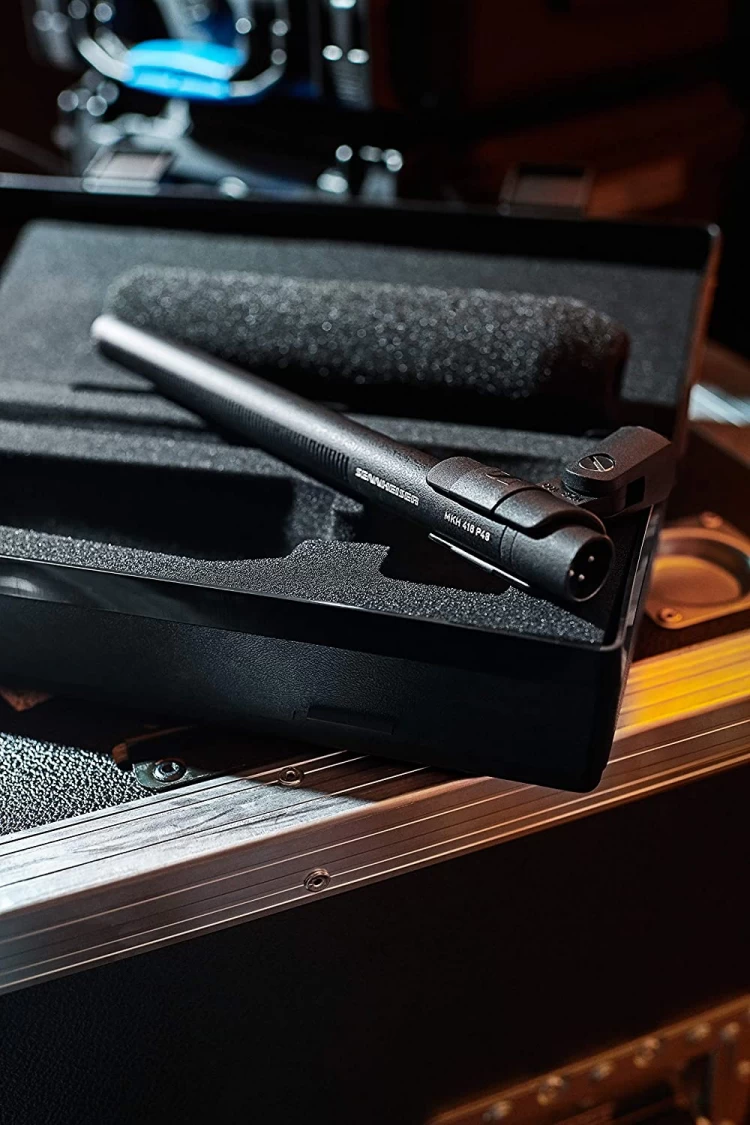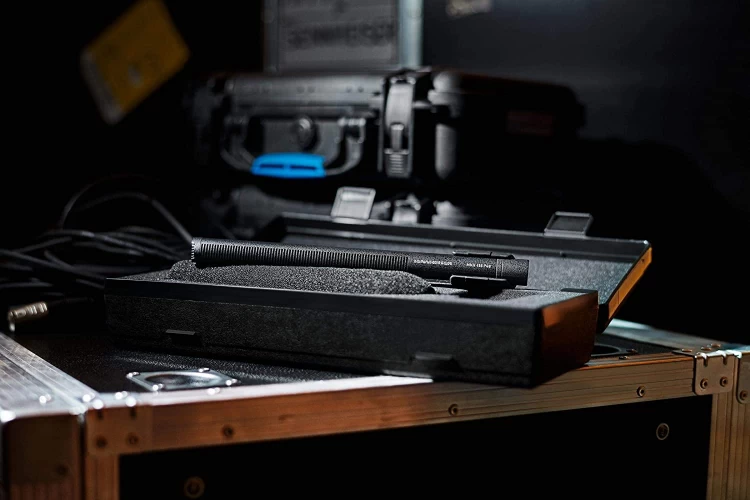Sennheiser Pro Audio MKH416 Review | Musician Nerd
Updated on Mar 16, 2022
Table of Contents
The Sennheiser Pro Audio MKH416 is one of the top-rated boom microphones on the market right now, boasting superior sound quality & noise control. Compared to other microphones for content creation, it comes at quite a cost. Sennheiser has been known to develop incredible products on the higher-end, and the MKH416 is the perfect example of that.

Sennheiser Pro Audio MKH416 Microphone In Case
Our team has worked with nearly every popular microphone on the market in multiple capacities, and the one thing we can say is that a high price point does not always correlate with the microphone quality. For that reason, we'll be trying to determine not only the pros and cons of the MKH416 but also whether or not it's deserving of the high price tag.
As we cover our favorite parts about the MKH416, we're going to talk about some of the more technical details. We're going to try our best to make sure it's understandable for all audiences as these specific features play a massive role in how microphones maintain maximum quality.
It's not all about the sound the microphone picks up, but about what sounds it doesn't. Background noise, especially depending on your filming environment, is one of the biggest challenges you'll face.
For this review, we'll be covering some of the highlights features the Sennheiser MKH416 has to offer. There's is a lot to love about this microphone, so we'll be covering it to its full capacity. This is one of our favorite reviews we've had the chance to work on. We'll run you through the list of pros and cons, that is if there are any cons, and by the end, you'll know if it's the right choice for you.
Why It's Great
The Sennheiser MKH416 is a compact pressure-gradient microphone that uses a short interference tube. It's great for working in any weather conditions, with a high immunity to humidity thanks to it's RF condenser design.

Sennheiser Pro Audio MKH416 Microphone On Wood Table
A lot of the projects we've worked on take place outdoors, and some locations or projects involve a wide variety of weather conditions. Higher-end microphones like the MKH416 are designed to withstand these conditions so that you can get the most out of your audio without clogging up the track. The rugged and highly durable design offers a great sense of protection, and it comes with the MZW415 windscreen as well.
Using a windscreen is important for protecting your audio from distortion. Similar to how recording studios will use a pop filter, windscreens act as a filter that blocks out moving air. The MZW415 is one I've used many times and offers incredible protection without softening your audio source.
Of course, the sound quality is one of the most important features. The best boom microphones focus on audio quality, directionality, and background noise. The Sennheiser MKH416 uses a super-cardioid condenser with a wide-frequency range of 40Hz to 20kHz. This offers a great level of depth for your audio while minimizing low-end frequencies (like traffic, A/C) from being picked up. Above 2kHz, the microphone goes into a Lobar pattern, offering the highest possible level of directionality. If you don't know, the directionality is when the microphone narrows down it's audio pick up to the target it's aimed towards. The Lobar pattern is specific only to shotgun microphones like the MKH416.

Sennheiser Pro Audio MKH416 Microphone With Foam In Case
This microphone is also highly sensitive, which also adds to the level of detail you can achieve when recording your target sound sources. The higher the sensitivity, paired with the frequency response, you'll be able to record the sound waves with total accuracy. But what about the noise we don't want? The side slots offer superior off-axis rejection, blocking out noise from the sides and rear of our microphone. At lower frequencies, it remains hyper-cardioid, so that the directionality maintains sharp.
Using a more versatile approach to the microphone capsule to allow these shifts in patterns is one of the single reasons this microphone is worth the price tag. Working with the different frequencies in audio is its own challenge, and using a microphone that knows what's good & bad will save you a lot of hassle in the long run.
For some, a lot of this information may be difficult to keep up with. But a lot of these features we mentioned really highlight the level of detail Sennhieser put into the MKH416 to make sure not only that the sound you record is of high quality, but that you can focus more on your target audio source and less on your environment.
What It's Good For
The Sennheiser Pro Audio MKH416 is one of the best boom microphones on the market. For this reason, it's very well suited and designed for film projects. As we've said before, the microphone comes with quite the price tag, and unless you've been in the space for a while, you may not understand whether you need everything it has to offer.

Sennheiser MKH416 P48U3 Shotgun Tube Microphone
I've mostly seen the Sennheiser MKH416 used on film sets, both indoors and out. If you're filming in poor weather conditions, it's going to be leagues ahead of some more affordable options thanks to the quality of design. It's also a great choice if you anticipate a lot of background noise, such as filming in public places. There are definitely more affordable microphones that offer great sound quality, so those who are feeling weary of the price should consider these types of factors to determine whether or not it's worth the cost.
That being said, I've worked with people who do voice-over work in their own homes and want the maximum quality they can achieve. If that sounds like you, it's important to factor in how much spending power you have on a personal level. If the nearly 4-figure price tag is a lot for you, then you might want to consider some of the alternatives we mention later on in this article.
The Downsides
It's not common that we don't have at least one thing to critique, but with the Sennheiser MKH416-P48U3, there's nothing bad I can bring up. It's an absolutely incredible microphone, definitely at the top of the league. All I can say is, if it's in your price range, don't even hesitate.
Pros & Cons
Pros
- Incredible Sound
- Very Rugged & Durable
- Highly Directional
- Minimal Background Interference
Cons
- Expensive (and well worth it)
Best Used For
- Film Audio
Alternatives
The Rode NTG3B is another one of my all-time favorite boom microphones on the market, offering a great balance between cost and quality. If your budget is over $500 but you want something a little more affordable than the MKH416, this may be a fine choice.

Rode NTG3B Super-Cardioid Microphone
The Rode NTG3B has both high sensitivity and superior directionality. You're going to get the full range of detail from your target audio source with minimal background noise. It's capable of withstanding adverse environmental conditions, and I've used it for work outdoors in all types of weather.
The Rode NTG3B will always remain one of my top suggestions for microphones in the film industry. The quality is incredible & it's definitely the flagship from Rode when it comes to film.
The Audio Technia AT897 is another favorite recommendation of mine. Yes, it comes at a much lower cost than the Sennheiser MKH416, and the quality is reflective of that, but for those on a little more of a budget, it's a fantastic choice.

Audio Technica AT897 Microphone On Stand
It's a short-capsule microphone coming in under 1ft in length, allowing you to easily keep it out of the camera shot. The on-axis recording quality brings out a natural sound, capturing the details of what you're recording, while the off-axis rejection prevents the background from being too overpowering. It definitely rises to the top in its price range for this very reason.
Again, it's certainly a few steps down from the MKH416, but it's definitely a stand out microphone in it's own market. If you're on a stricter budget, you cannot go wrong.
Summary
If you're looking for one of the best microphones to use for your next project, you can't go wrong with the Sennheiser MKH416. The sound quality is outstanding, the noise control and weather handling are industry standard, and you can feel the level of quality in the materials used. It's so well-rounded and one of my favorite microphones on the market.
As we've mentioned earlier, rarely, we don't have anything to critique. The Sennheiser MKH416 is one of the few microphones we've reviewed that truly deserves the 10/10 score and one we recommend with total confidence.
So, what do you think? Are you going to take the jump and get set up with the Sennheiser MKH416? If so, let us know how it's working out for you! We love to hear valuable feedback from our audience as it helps us better serve our future readers. If you have any content you've created, feel free to link it below! We love seeing your creations.
Posted on Aug 14, 2021
Recording Streaming
Have questions for us? Email us at info@musiciannerd.com
